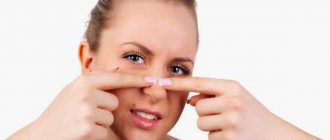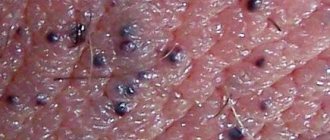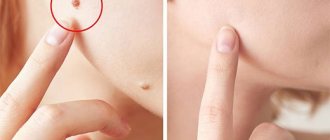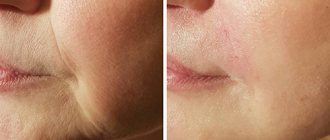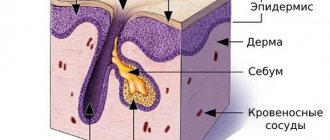Blackheads or comedones are a common problem not only among young people growing up, but also among adults. Most often, the cause is an imbalance of the hormonal system or improper hygiene. The greatest accumulation of comedones is observed in the nose, cheeks and chin. But in some cases they can also be found on the ears. How to get rid of blackheads in the ears at home, what is the reason for their appearance?
Why do ear pores get clogged?
The reasons for the appearance of blackheads or comedones in the auricle are very different:
- Hormonal disbalance.
- Poor hygiene.
- Poor nutrition. Fast foods and sweets lead to an increase in insulin. The hormone, in turn, increases the production of testosterone, which affects the speed of the sebaceous glands. Sebum clogs the ducts, after which unpleasant rashes appear.
- A child may also develop dots, but this is due to poor hygiene or reduced immunity.
- Low-quality cosmetics containing chemicals also contribute to the appearance of sebaceous plugs.
- Traffic jams appear with low consumption of foods with vitamins E and A.
- Sex hormones are another cause of acne.
- Colds and allergies.
- Excessive cleanliness, when the ear canals are cleaned every week.
- Headphones of dubious purity that are inserted into the ears.
Plugs in the ears can be closed or open. Open black pimples can be squeezed out, but white or closed pimples are dangerous to squeeze out.
Why do white comedones appear? Subcutaneous sebum accumulates in the pores, but does not find a way out, since the pores remain closed. Pus and sebum accumulate there, causing white bumps to form.
Cleaning ears with wax plugs
People most often come to an otolaryngologist with complaints about earwax. In this case, patients experience hearing impairment, the cause of which is clogging of the ear canal with sulfur. The substance contains a lubricating secretion of glands and keratinized epithelial particles.
Often, a noticeable decrease in the ability to perceive sounds is observed after taking water procedures, swimming, when water gets into the ears. The cause of aching or sharp “shooting” pain is swelling of the conglomerate. If you have pain symptoms, you should contact a medical facility as soon as possible; you should not try to clear wax from your ears on your own, as this can lead to the development of complications.
Ways to get rid of comedones
Many people do not even notice that they have such problems in their ears. Acne in these places does not make itself felt for the time being until it becomes inflamed. Once inflamed, they become painful, preventing you from touching your ears. This is where a person begins to wonder, what to do with these ugly rashes?
There are many medications and medical treatments that only a doctor can prescribe. A dermatologist or cosmetologist can pop out all the pimples using special tools.
The doctor may also prescribe the following medications:
- Differin fights inflammation by exfoliating the top layer of the dermis.
- Skinoren reduces the level of lipids and acids in subcutaneous fat, reducing its viscosity.
- Retinol perfectly dilutes the secretions of the glands, clearing the plugs.
- Ichthyol ointment cleanses the skin even of those plugs that lie deep in the layers of the epidermis.
- Salicylic acid promotes the release of sebum, thereby helping to get rid of blackheads.
- The antibacterial agent Zenerit cleanses the skin of acne well.
Preventing the formation of blackheads in the ear
The main preventive measures to prevent the formation of blackheads include:
- Ear hygiene is the main procedure to prevent the occurrence of open comedones. When washing, you need to thoroughly wash out the contents of the organ shell. Low-quality soap, cheap shampoos, and rinses clog skin pores.
- After washing off any remaining cosmetic products, the ears should be wiped dry. In a humid environment, pathogenic microorganisms accumulate and multiply. They provoke the occurrence of inflamed acne.
- If black, inflamed spots on the ears often occur, you should regularly use tar soap and antiseptics to prevent pathology.
- If the occurrence of open comedones is associated with hormonal and endocrine diseases, the underlying disease must be treated.
- Proper nutrition prevents many pathologies. Reducing your carbohydrate intake helps combat the problem.
- If pimples constantly pop up, it is better to consult a dermatologist or cosmetologist. He will find the true cause of the disease and help remove comedones.
The correct approach to the treatment of unaesthetic blackheads will help restore purity and beauty.
The article has been reviewed by the site editors
Folk remedies against comedones
The most accessible folk remedies will help you get rid of blackheads. The first remedy is hydrogen peroxide. With its help, you can remove even those acne that is located deep in the ear canal.
If the acne is visible, then you need to apply a cotton swab soaked in peroxide to it. If the acne is inside the ear canal, then peroxide can be instilled inside. Then take a cotton swab and clean the ear canal. It is recommended to lie down with the sore ear down so that the excess peroxide drains off, disinfecting the acne.
If acne appears in the ear canals or outside, then use a soda solution: 1 teaspoon of soda per glass of warm water. This warm solution must be dropped into ears with acne. You can add another 1 teaspoon of salt and drop a drop of iodine. Soak a cotton swab in this solution and apply it frequently to problem areas, holding it there for 20 minutes.
Many people manage to remove blackheads using a tea bag. Immerse the bag in hot water, squeeze it out, apply it to the problem area, and cover with a handkerchief.
The tea contains theine, which when warm reduces inflammation, thereby helping to treat acne.
Milk can also remove blackheads. It contains substances that will help remove dead cells and cleanse pores. The compress can be left in the ear canal for 10-15 minutes, then rinsed. The procedure will have to be done 3-4 times a day to get a visible result.
Ear plugs: main causes
The ears have a complex structure; the sulfur glands perform a protective function. The external auditory canal connects the eardrum to the outside world and is a curved, hollow tube. The outer part of the passage has a membranous-cartilaginous structure, the inner part has a bone structure. The outer part contains sulfur glands.
The number of sulfur glands can reach two thousand. Harmful microorganisms and dust particles stick to the secretion they produce. This is how the protection system works, preventing infectious agents and debris from entering the deep places of the ear canal. The skin of the ear canal regenerates very quickly, and epithelial cells divide in an outward direction. There is a constant production of sulfur; up to 20 mg of secretion can be formed per day. This mass gradually moves towards the entrance along with added contaminants. This process is usually invisible to a healthy person. Daily cleaning of the vestibule of the ear canal and wiping the outer part with water ensures comfortable cleaning of accumulated wax.
What is the reason for the accumulation of secretion in the ear? Ear wax can form due to improper cleaning or neglect of personal hygiene rules.
Often people use a cotton swab to push the sulfur into the bone region, trying to immerse it as deeply as possible. Such manipulations damage the skin of the ear canal, which causes increased secretion production. This mass is formed in large quantities and does not have time to come out on its own, it is compressed. Diseases of the digestive system and metabolic disorders can also create a violation of the consistency of the sulfur glands or increased secretion.
Some factors can cause hearing loss:
- genetic predisposition (increased viscosity of gland secretions, excessive hair growth, and some structural features of the canal are often inherited);
- staying in areas where there are sharp changes in atmospheric pressure (swimming at great depths, hiking in the mountains);
- frequent inflammatory processes in the nasopharynx during ARVI (enlarged adenoids in children with a chronic inflammatory process can cause ear plugs);
- the use of in-ear headphones and other sound amplifiers (long telephone conversations cause increased release of conglomerate);
- various skin diseases (the outflow of sulfur can be complicated due to psoriasis, dermatitis; inflammatory processes of the skin affect the cartilaginous part of the canal).
Poor nutrition can also cause increased secretion production. The presence of a high concentration of cholesterol in the blood makes sulfur viscous and accelerates hair growth.
Mechanical acne removal
It is unlikely that you will be able to squeeze out acne in your ears with your hands.
Black fat dots can be removed this way:
- Steam the skin of the ears and around the auricle by applying a cotton pad dipped in hot water.
- Disinfect hands and tools with alcohol.
- Also wipe the problem area with medical alcohol, massaging the area with blackheads.
- Press on the blackheads with a special tool, then the steamed comedones will quickly come out.
- Apply alcohol to the problem area.
To prevent acne from appearing again, lubricate the treated area with tea tree oil. Its antibacterial properties will help destroy dangerous microorganisms and speed up healing. The oil is too concentrated, so it is diluted with water 1:9.
Cold is the enemy of the ears
Exposure of the ears to low temperatures can cause inflammation. This will be followed by pain, a feeling of congestion and extraneous noise, swelling, and the development of otitis (internal, external). During the cold season, it is imperative to protect your ears. The headdress should cover more than just the top of the head.
How to remove acne in children
An adult's skin is denser, so consequences after mechanical removal rarely occur. But it’s better to have the dark spots in the baby’s ears removed by a doctor. You can try making compresses at home:
- Compress with Vishnevsky ointment. Apply a little of the drug to a cotton swab, apply to black pimples, and attach with a band-aid. Sometimes it is enough to do the procedure at night and the problem will disappear.
- Levomycetin drops act in the same way. A compress with drops will help remove unsightly rashes. If acne has formed inside the ear canal, then these drops are instilled inside.
- Tar soap acts on the problem in the same way as Vishnevsky ointment. You can wash your child's ears with soap so that pimples never appear.
- Young children can apply aloe or Kalanchoe leaves.
- Lemon juice will also do the job perfectly. Also apply a cotton swab soaked in citrus juice to the rashes.
- Applying warm honey to acne will help get rid of them in 2-3 treatments.
If you see acne inside your baby's ear, don't dismiss the problem. Do your best to get rid of the rashes.
Open comedones with black heads
Open comedones are the openings of hair follicles clogged with sebum. In addition to sebum, dust, residues of cosmetic products, and dead skin cells accumulate in the follicles. As all this debris accumulates, it stretches the edges of the follicle. The open part of the cork oxidizes under the influence of oxygen and turns black. It takes on the appearance of a black dot on the skin.
The top of the sebaceous plug is not always black. Its color can vary from dirty yellow and gray to dark brown. The diameter of the eel is usually no more than 2 mm. The thicker the sebum, the more enlarged the pore is. In small eels, the contents are more liquid.
The absence of inflammation and a small number of acne are considered normal. But an open comedone can become infected. In this case, inflammation will develop in place of the small dark spot and an abscess will form. Improper care can cause the infection to spread from the source of inflammation to a larger area of the skin.
Acne is inflamed and painful, what should I do?
If an inflamed acne hurts, you can apply a cotton swab dipped in aloe juice and hold for 25 minutes. Perform this manipulation until healing.
An apple cider vinegar compress will also quickly help cope with this skin disease.
Tea tree oil and all antiseptic preparations will definitely help cope with the problem.
But squeezing out an inflamed comedone is not recommended. You can cause an infection and delay healing.
What to do in case of inflammation
Some people, not knowing how to properly squeeze a blackhead out of their ear, introduce an infection there or injure the tissue, causing inflammation. To eliminate the problem, you can use aloe juice and pulp.
To do this, take a three-year-old plant, cut off a leaf and divide it into two halves. The fleshy part with juice is applied to the auricle and held for 20 minutes. Repeat the procedure until complete healing.
An inflamed ear comedone can be eliminated with any antiseptic - calendula tincture, eucalyptus alcohol solution. The only thing you shouldn’t do is squeeze out the pus-filled acne. This will lead to increased inflammation and the spread of infection.
Prevention measures
To prevent blackheads from ruining your life, be sure to take preventive measures:
- Wash your ears as often as your face, using high-quality cosmetics. Just don't go deep inside the ear canal.
- Wipe dry after washing.
- Do not try to clean them often with cotton swabs, do not remove the natural protective lubricant.
- Include more fresh vegetables and fruits in your menu.
- Avoid acne inflammation.
- Wash your headphones if you have to use them.
Dear friends, knowing how to remove blackheads from your ears will definitely help you avoid this unpleasant problem.
Option 3: honey massage
If possible, you can buy natural, village honey. Only liquid should be used. Honey is applied to the ears with massaging movements.
After 10 minutes, you can wash off the composition with water. The healing components should be applied daily until the black dot in the ear disappears and the skin visually becomes ideal. Then the procedure is carried out once a week so that the rash does not appear again.
Causes and types
Comedones are non-inflammatory rashes, the occurrence of which signals disturbances in the functioning of the gastrointestinal tract, endocrine system, and liver. To find out why black cysts appear on the ears, it is necessary to consider the causes and factors that provoke their formation.
Acne on the earlobes appears due to blockage of the follicles with dust, natural fat, and keratinized epidermal cells. When exposed to oxygen, the resulting plugs oxidize, causing them to turn black. They do not cause pain in the ear, but cause a cosmetic defect.
Like pimples, pinpoint growths can become inflamed, but only if you try to remove them yourself. Mechanical damage to the skin of the ears is fraught with infection, inflammation of the follicles and the formation of ulcers. When pressed, pus and light yellow ichor are released from the pimple.
There are two types of comedones in the ears:
- Closed (whiteheads) are nodular neoplasms with a diameter of up to 2 mm, which are detected when the skin is stretched. When pressed, dense masses are difficult to separate from them. Such points often become inflamed, causing the appearance of regular acne.
- Open (blackheads) are cysts that are located at the mouth of the hair follicles. They acquire a black color due to the content of melanin, which is oxidized by oxygen. When pressed, dense dark yellow masses are easily released from the pores in the auricle.
Black spots in a child’s ears occur due to metabolic disorders, digestive disorders, poor hygiene, hyperkeratosis, etc. Cysts often occur during puberty due to hormonal imbalance in the body. The following can cause acne in the ear:
- increased testosterone levels;
- hereditary predisposition;
- stressful situations;
- vitamin and mineral deficiency;
- poisoning of the body with toxins;
- non-compliance with sanitary and hygienic rules;
- abuse of hormonal drugs;
- poor nutrition (eating fatty foods);
- endocrine diseases;
- frequent constipation and intestinal obstruction.
According to statistics, ear rashes more often appear when hygiene rules are not followed and low-quality cosmetics are used. Fatty ointments, powders, and foundations clog the skin, which creates conditions for the formation of comedones at the mouths of the follicles.
Carrying out diagnostics
Any of the listed symptoms require immediate medical attention. Usually, an experienced doctor can make the correct diagnosis after an otoscopy, based on the clinical picture and objective examination data. Fungal masses of black, gray, yellow, greenish, and white are found in the external auditory canal (depending on the causative agent of otomycosis). These masses are easily separated from the skin and are accompanied by the discharge of serous fluid from the ear.
Difficulties in differentiating otomycosis may arise if it is caused by candida, since candidomycosis superficially resembles weeping eczema. In this regard, if you suspect an ear fungus, you should definitely carry out a smear analysis from the ear canal (microscopy, culture, etc.) or microotoscopy. For long-term mycosis, it is necessary to do audiometry (test of auditory function), and, if necessary, CT scan or x-ray of the temporal bone.

